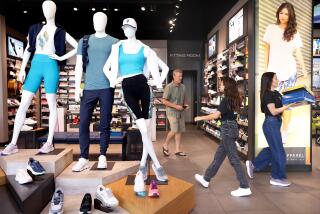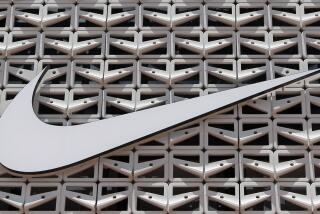Sockets’ Red Glare : Oakley’s Legal Attack on Nike Illustrates the Competitiveness of the Sunglasses Industry
- Share via
SANTA ANA — The sunglasses wars escalated Thursday as Oakley Inc. filed suit against industry newcomer Nike Inc. for allegedly infringing on a patent covering several of Oakley’s high-tech eye-wear designs.
Oakley’s legal attack on Nike illustrates the competitive nature of the industry, where established players such as Foothill Ranch-based Oakley are battling for an increased share of what’s now a $2.5-billion market.
Americans bought 113 million pairs of sunglasses last year at retail shops, and millions of pairs at swap meets. Competition is hottest in the upscale end of the market, which begins at $30 and quickly soars to hundreds of dollars per pair.
“A lot of companies are entering that part of the market with different models,” said Richard Enholm, market research director of the Norwalk, Conn.-based Sunglass Assn. of America.
Oakley’s suit alleges that newer models of Nike’s upscale sunglasses--which retail for as much as $250--infringe on a newly issued patent covering integral parts of Oakley’s X Metal and Fives designs.
Oakley founder and Chairman Jim Jannard, who counts Nike founder and Chairman Phil Knight as a friend, said he intends to protect his company’s optical technology.
“Our competitors feel a need to use our inventions,” Jannard said in a press release. “While this is flattering, it is not acceptable.”
Nike declined to comment on the suit, which was filed in U.S. District Court in Santa Ana.
*
Oakley has a reputation for using litigation against competitors. In recent years, it has sued Bausch & Lomb, Foster-Grant, Arnette and other manufacturers for allegedly infringing on its patents.
The latest suit comes two years after Nike, based in Beaverton, Ore., entered the sunglass and eye-wear market with a narrow product line aimed mainly at track and off-road runners.
Analysts say that a product glut and weaker-than-expected demand has generated disappointing results for some manufacturers.
In October, Oakley’s stock was hammered after Sunglass Hut International, the nation’s leading sunglass retailer, experienced a sales slowdown. The sales stall has been especially painful for Oakley because a third of the company’s sales are generated by the Coral Gables, Fla.-based chain.
Oakley’s shares have rebounded somewhat in recent weeks, but the company on Thursday released a new earnings report that Chief Operating Officer Link Newcomb described as disappointing.
*
Oakley said net income for the second quarter fell to $8.8 million, or 13 cents per share, from $15.7 million, or 22 cents per share, a year earlier. Revenue fell 12% to $55.2 million from $62.8 million.
But Newcomb--and some industry analysts--expect the company’s second-half performance to improve as Oakley introduces new product and Sunglass Hut resolves its excess inventory problem.
Oakley and Nike’s dispute centers on strong, lightweight glasses that reduce glare and improve depth perception--key attributes for athletes. The products feature optical advances that make it possible to incorporate curved lenses that don’t distort vision.
Oakley, which bills its goods as technically sophisticated eye wear for athletes, has enjoyed “a very singular position” in the athletic-oriented segment, said Marge Axelrad, editorial director for 20/20, a New York-based eye-wear trade magazine.
But the company faces stiffening competition from apparel companies such as Armani and Calvin Klein, Axelrad said, “and now you’ve got mega-brands like Nike, Fila, Adidas and Reebok coming into the segment.”
Nike and Oakley court serious athletes who demand solid performance from their sports equipment.
*
Both companies count Michael Jordan as their top pitchman: The NBA superstar wears Nike shoes and apparel but serves on Oakley’s board of directors and wears only Oakley sunglasses.
“Consumers are very influenced by celebrities, as well as what’s hot in the fashion industry,” said Barbara M. Kelley, spokeswoman for Bausch & Lomb, the nation’s largest sunglass manufacturer.
Bausch & Lomb, which owns the Ray-Ban line, knows the value of star appeal from past years when Tom Cruise drove sales of classic designs showcased in the movies “Risky Business” and “Top Gun.”
This summer, sales of Ray-Ban’s Predator 2 line are sizzling, thanks to “Men in Black,” the blockbuster movie featuring actors Tommy Lee Jones and Will Smith, who regularly don the black-rimmed glasses to protect their eyes from memory-erasing neutralizers.
“We’ve seen a doubling in sales since the movie opened on July 2,” Kelley said. “In fact, we’re getting feedback that people are starting to steal the ‘Men in Black’ displays and merchandising in stores . . . so the attention the movie is generating is very helpful.”
Sunglass industry observers expect athletic apparel companies now entering the sun-wear industry to harness the same marketing savvy they’ve used to pitch costly tennis shoes and sweat shirts to the most dedicated couch potatoes.
*
Nike, which has limited sales of its new sunglass line to running stores and other athletic-goods outlets, recently began to broaden its marketing push by offering its eye wear at Sunglass Hut’s 2,000 locations.
“It marks the first time that Nike has moved out of the sports specialty distribution,” analyst Axelrad said. “And it marks an important point in popularizing Nike in the overall sunglass market.”
Oakley, which rarely talks publicly about its business plans, assured shareholders during a June annual meeting that the company isn’t willing to cede market share.
“We didn’t go into this business to compete for second place,” said Jannard, who also boasted that “we have never lost a patent litigation in hundreds of skirmishes.”
Oakley’s shares fell by $1.06 to $12.50 Thursday, and Nike rose by $1.19 to $61.94. Both stocks are traded on the New York Stock Exchange.
More to Read
Inside the business of entertainment
The Wide Shot brings you news, analysis and insights on everything from streaming wars to production — and what it all means for the future.
You may occasionally receive promotional content from the Los Angeles Times.










